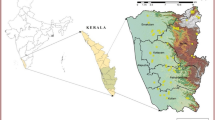Abstract
Labile organic carbon (LOC) is one of the most important indicators of soil organic matter quality and dynamics elevation and plays important function in the Tibetan Plateau climate. However, it is unknown what the sources and causes of LOC contamination are. In this study, soil organic carbon (SOC), total nitrogen (TN), microbial biomass carbon (MBC), microbial biomass nitrogen (MBN) and LOC were analyzed based on different soil horizons and elevations using turnover time in an experimental site (3700 m to 4300 m area) in Sygera. SOC and LOC in higher-elevation vegetation types were higher than that of in lower-elevation vegetation types. Our results presented that the soil microbial biomass carbon (SMBC) and soil microbial biomass nitrogen (SMBN) were positively correlated with SOC. The content of easily oxidized carbon (EOC), particulate organic carbon (POC) and light fraction organic carbon (LFOC) decreased with depth increasing and the content were the lowest in the 60 cm to 100 cm depth. The total SOC, ROC and POC contents decreased with increasing soil horizons. The SOC, TN, MBC and MBN contents increased with increasing altitude in the Sygera Mountains. The MBC and MBN contents were different with the changes of SOC (p<0.05), meanwhile, both LFOC and POC were related to total SOC (p<0.05). The physical and chemical properties of soil, including temperature, humidity, and altitude, were involved in the regulation of SOC, TN, MBC, MBN and LFOC contents in the Sygera Mountains, Tibetan Plateau.
Similar content being viewed by others
References
Bauhus J, Pare D, Cote L (1998) Effects of tree species stand age and soil type on soil microbial biomass and activity in a southern boreal forest. Soil Biology and Biochemistry 30: 1077–1089.
Blair GJ, Lefroy RDB, Lisle L (1995) Soil carbon fractions based on their degree of oxidation, and the development of a carbon management index for agricultural systems. Australian Journal of Agricultural Research 46: 1459–1466.
Cambardella C, Elliott E (1992) Particulate soil organic matter changes across a grassland cultivate sequence. Soil Science Society of America Journal 56: 777–783.
Caron J, Espindola CR, Angers DA (1996) Soil structural stability during rapid wetting: Influence of land use on some aggregate properties. Soil Science Society of America Journal 60: 901–908.
Christopher S (1999) Terrestrial biomass and effects of deforestation on the global carbon cycle. Bioscience 49: 769–778.
Davidson EA, Janssens IA, Luo YQ (2006) On the variability of respiration in terrestrial ecosystems: moving beyond Q10. Global Change Biology 12: 154–164.
Fang C, Moncrieff JB (2001) The dependence of soil CO2 efflux on temperature. Soil Biologyical Biochemistry 3: 155–165.
Hontoria C, Rodriguez MJC, Saa A (1999) Relationships between soil organic carbon and site characteristics in Peninsular Spain. Soil Science Society of America Journal 63: 614–621.
Krull ES, Baldock JA, Skjemstad JQ (2003) Importance of mechanism and processes of the stabilization of soil organic matter for modeling carbon turnover. Function Plant Biology 30: 207–222.
Liu MQ, Hu F, Chen XY (2007) A review on mechanisms of soil organic carbon stabilization. Acta Ecologica Sinica 27: 2642–2650.
Lovell RD, Jarvis SC (1998) Soil microbial biomass and activity in soil from different grassland management treatments stored under controlled conditions. Soil Biology & Biochemistry 30: 2077–2085.
Pan GX, Li LQ, Zhang XH, et al. (2003) Soil organic carbon storage of china and the sequestration dynamics in agricultural lands. Advances in Earth Science 18: 609–618.
Peng XH, Zhang B, Zhao QG (2004) A review on relationship between soil organic carbon pools and soil structure stability. Acta Pedologica Sinica 41: 618–623.
Shao JA, Tang XH, Wei CF, et al. (2007) Effects of conservation tillage on soil organic matter in paddy rice cultivation. Acta Ecological Sinica 27: 4434–4442.
Smith JI, Halvorson JJ, Bolton HJr (2002) Soil properties and microbial activity across a 500m elevation gradient in a semiarid environment. Soil Biology & Biochemistry 34: 1749–1757.
Vance ED, Brookes PC, Jenkinson DS (1987) An extraction method for measuring soil microbial biomass C. Soil Biology & Biochemistry 19: 703–707.
Vanlauwe B, Nwoke OC, Sanginga N, et al. (1999) Evaluation of methods for measuring microbial biomass C and N and relationships between microbial biomass and soil organic matter particle size classes in West-African soils. Soil Biology & Biochemistry 31: 1071–1082.
Warder DAA (1992) Comparative assessment of factors which influence microbial biomass carbon and nitrogen levels in soil. Biological Reviews 67: 321–356.
Xie XL, Sun B, Zhou HZ, et al. (2004) Soil carbon stocks and their influencing factors under native vegetations in China. Acta Pedologica Sinica 1: 687–699.
Yadvinder M, Grace J (2000) Tropical forest and atmospheric carbon dioxide. Tree 15: 332–337.
Yang LX, Pan JJ (2003) Dynanics models of soil organic carbon. Journal of Forest Research 14: 323–330.
Zhang GS, Huang GB, Yin C (2005) Soil organic carbon sequestration potential in cropland. Acta Ecological Sinica 25: 351–357.
Zheng D, Yao TD (2004) Uplifting of Tibetan Plateau with its environmental effects. Science Press, Beijing, China.
Zhou GS, Wang YH, Jiang TL, et al. (2002) Conversion of terrestrial ecosystems and carbon cycling. Acta Phytoecologica Sinica 26: 250–254.
Zhou L, Li BG, Zhou GS (2005) Advances in controlling factors of soil organic carbon. Advances in Earth Science 20: 99–105.
Author information
Authors and Affiliations
Corresponding author
Additional information
http://orcid.org/0000-0003-1450-4915
http://orcid.org/0000-0002-8262-8568
http://orcid.org/0000-0002-3591-5943
http://orcid.org/0000-0002-7258-8208
http://orcid.org/0000-0003-4686-2506
Rights and permissions
About this article
Cite this article
Ma, Hp., Yang, Xl., Guo, Qq. et al. Soil organic carbon pool along different altitudinal level in the Sygera Mountains, Tibetan Plateau. J. Mt. Sci. 13, 476–483 (2016). https://doi.org/10.1007/s11629-014-3421-6
Received:
Revised:
Accepted:
Published:
Issue Date:
DOI: https://doi.org/10.1007/s11629-014-3421-6




